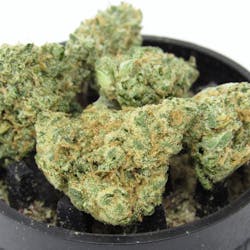For a how-to explainer on Leafly’s new Cannabis Guide, check out Part 1 of this series.
Jump to a section in Part 2:
- Reimagining the indica/sativa system
- Increased hybridization and the entourage effect
- The reliability of strain names
- Begin exploring cannabis strains on Leafly
Cannabis consumers are ultimately concerned with the effects of a strain—how it will make them feel after smoking or ingesting it. Leafly’s Cannabis Guide is a tool to help consumers answer that question for themselves.
“It’s really about helping cannabis consumers find the right strain and the right product as quickly and easily as possible,” says Nick Jikomes, Leafly’s Principal Research Scientist. “We want people to see the difference between products when a real difference exists. We want you to be able to see with your eyes what you can’t smell with your nose.”
Back when Leafly first started in 2010 and up until now, we have used a three-tile system, which classifies cannabis strains as indica (purple), sativa (red), or hybrid (green).
That static system wasn’t based on lab data from growers. The new Cannabis Guide is a dynamic system that uses a combination of lab-sourced data and hundreds of thousands of customer reviews from app and website users.
Leafly works with the best cannabis labs in the US and Canada and is constantly onboarding more lab partners for data; the more data samples of cannabis strains, the better.
Reimagining the indica/sativa system
For decades, cannabis has been classified as either an indica, sativa, or hybrid. These terms refer to the forms of cannabis with different physical features, Cannabis sativa and Cannabis indica, with hybrid being a genetic cross of the two. Typically, sativas grow tall and thin, while indicas grow short and stout.
Because indicas and sativas can have specific physical traits, it has led to the assumption that each also has certain effects, but this is insufficient. Regardless of whether a strain is an indica or sativa, its chemical profile—that is, the cannabinoids and terpenes in it—will determine how it affects you, not its physical features.

Three sativas in the Cannabis Guide, all with very different cannabinoid and terpene profiles, meaning each will likely give different effects.
The above graphic shows a flaw of using the indica/sativa system. All three strains are commonly classified as sativas, yet they all have very different terpene profiles. Because a chemical profile leads to feelings and effects, even though all of these strains are sativas, they likely will not have the same feelings and effects.
Increased hybridization and the entourage effect
Due to decades of cannabis prohibition, research on the plant is limited. One thing we do know, as shown in a 2017 study and a 2015 study, is that it’s difficult to find a true sativa or indica. Decades of crossbreeding and hybridization has made it so strains that are thought to be sativas can actually turn out to be indicas upon genetic analysis.
Shop highly rated dispensaries near you
Showing you dispensaries nearA 2010 review article by Dr. Ethan Russo, a pioneer in the study of the body’s endocannabinoid system, points to the importance of cannabinoids and terpenes and the benefits they can provide. Their importance comes from the entourage effect—how cannabinoids and terpenes work together and with other compounds in the body to unlock the wellness benefits of cannabis.
This theory describes how certain components of cannabis might work together to provide benefits, such as relief from pain, inflammation, depression, anxiety, and much more.
For more information on the indica/sativa debate, the entourage effect, and the importance of cannabinoids and terpenes, check out our article Indica vs. sativa: What’s the difference between cannabis types?
The reliability of strain names
The flowers you see in Leafly’s Cannabis Guide represent the average of all data from our lab partners. When you look at the Blue Dream flower or any other flower, its chemical profile is an aggregate of data samples from hundreds of growers.
Let’s say a grower produces a product that they market and sell as “Blue Dream,” but it doesn’t align with the average of Leafly’s data from our lab partners—is it really “Blue Dream?”

Leafly’s Blue Dream (left) which is an average of thousands of data samples, and a strain marketed as “Blue Dream” (right). Is it really Blue Dream?
Above you’ll see the most common profile of Blue Dream on the left, which appears in Leafly’s Cannabis Guide. This is an average of all the data samples from Leafly’s lab partners.
The flower on the right is a version of Blue Dream that falls outside of the average of all the data; it’s an extreme outlier. Although it does contain myrcene (dark blue) and pinene (green), its dominant terpene is terpinolene (orange), which will likely produce different effects.
Although the strain on the right may be marketed as “Blue Dream,” it is probably not a true Blue Dream cultivar because its chemical profile doesn’t align with the average of data. Having this information will allow you to better tell if a product actually is what it says it is.
Begin exploring cannabis strains with Leafly’s Cannabis Guide
Now that you understand how to use Leafly’s Cannabis Guide and how cannabinoids and terpenes affect the experience of cannabis, you’ll be able to find a cannabis strain for your body and needs.
Remember that exploring strains that suit your unique body and needs is an important part of the process. Because all bodies and settings are different, the same strain can affect two people very differently, and it can also affect you very differently in two different circumstances.
The Cannabis Guide will give you a baseline so you can understand what’s in a strain. Depending on whether or not you like a strain, you can branch out and find another strain that’s similar, or you can try something different that might suit you better. You can sign up for an account and leave a review on Leafly to report how certain strains affect you and keep track of your favorites.
We encourage you to explore the Cannabis Guide. Learning the science behind cannabis and its effects will help you better understand and enjoy this wonderful plant!




